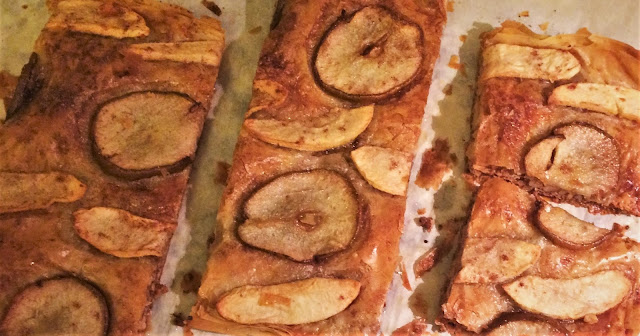A treat that's PERFECT FOR AUTUMN!!! Can be made vegan and/or Lent-friendly! A really nice, crunchy dessert made with phyllo dough and topped with pears, apples and cinnamon. There are some walnuts and sugar in it too. There's also butter, but if vegetable oil is used instead, the dessert becomes one hundred percent vegan and also suitable for Lent! That's one versatile recipe, isn't it?
Delicately sweet pears and tangy apples are arranged on top of sheets of cinnamony phyllo dough. As the dessert bakes the aromas of cinnamon fill the house: scrumptious! There is no syrup here as there usually is on phyllo desserts. The flavour is unique, and with the absence of syrup, calories are fewer! Syrup does prolong the life of phyllo desserts, therefore, this delicious crisp must be consumed shortly after it's baked.
Ingredients:
- 1/2 cup walnuts or pecans, or a combination of both, finely chopped
- 1/4 cup plain, unseasoned breadcrumbs
- 1/4 cup sugar, plus more for sprinkling
- 1/2 teaspoon ground cinnamon, plus more for dusting
- frozen phyllo dough, thawed in the refrigerator; you will be using only ten sheets of phyllo. There are several varieties of phyllo on the market, and some brands of phylo are wider than others. The amount of butter and fruit might have to be adjusted depending on the variety purchased.
- 1/2 stick (four tablespoons) unsalted butter, melted
- 3 Seckel pears, sliced thinly; Seckel pears are perfect as they are naturally small and will look gorgeous here! No need to peel the pears
- 2 baking apples, peeled and sliced thinly
- Place a rack in the top position of your oven.
- Preheat the oven to 350° F.
- Combine the walnuts, breadcrumbs, sugar and cinnamon.
- Line a baking sheet with parchment paper and top with 1 phyllo sheet.
- Using a pastry brush, brush the phyllo with butter; add another phyllo sheet on top. Brush the second sheet with butter. Add a third sheet of phyllo and guess what? Brush it with butter.
- Hint: don't press down with the pastry brush. Use light, airy strokes. The lighter the brushing, the flakier the phyllo layers will turn out.
- In each of the next four phyllo layers, the nut mixture will be used, so go ahead and divide the mixture into four portions. Use one portion for each layer:
- Add a fourth sheet and brush it with butter. Sprinkle a portion of the nut mixture on top.
- Repeat another 3 times, buttering each phyllo layer and adding nuts.
- Finally, top with two phyllo sheets, buttering each one. Top with the last phyllo sheet and go ahead, butter that one as well.
- Make sure that you brush the edges of the phyllo sheets with butter so that they won't dry up during baking. The original recipe called for a lot more butter but I cut down on the amount. Too much butter is unnecessary and makes for a heavy dessert. Therefore, don't soak the phyllo with butter. If you'd like to cut some of the butter amount even further, you can substitute part or all of it with a good vegetable oil. Do not, however, use olive oil.
- Arrange the pears and apples on top of the phyllo. Brush the fruit with the remaining butter, sprinkle with sugar and dust with cinnamon.
- Bake; rotate the baking sheet halfway through baking. After 25 minutes, when the phyllo is golden brown and the fruit is soft, the dessert is ready to take out of the oven. Let cool and slice into portions.
- The dessert should be eaten the same day; if kept longer, the phyllo will begin to lose its crispness.
This recipe has been adapted from Martha Stewart. It's a wonderful one, thanks, Martha!






